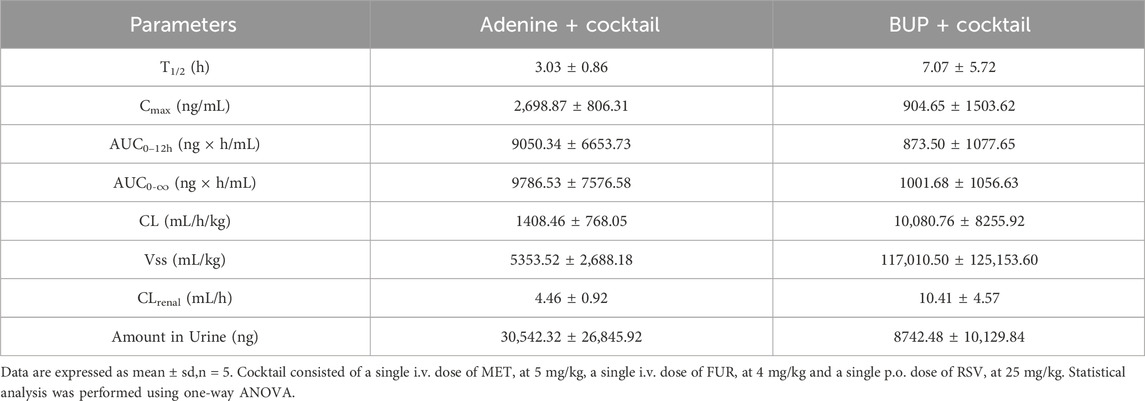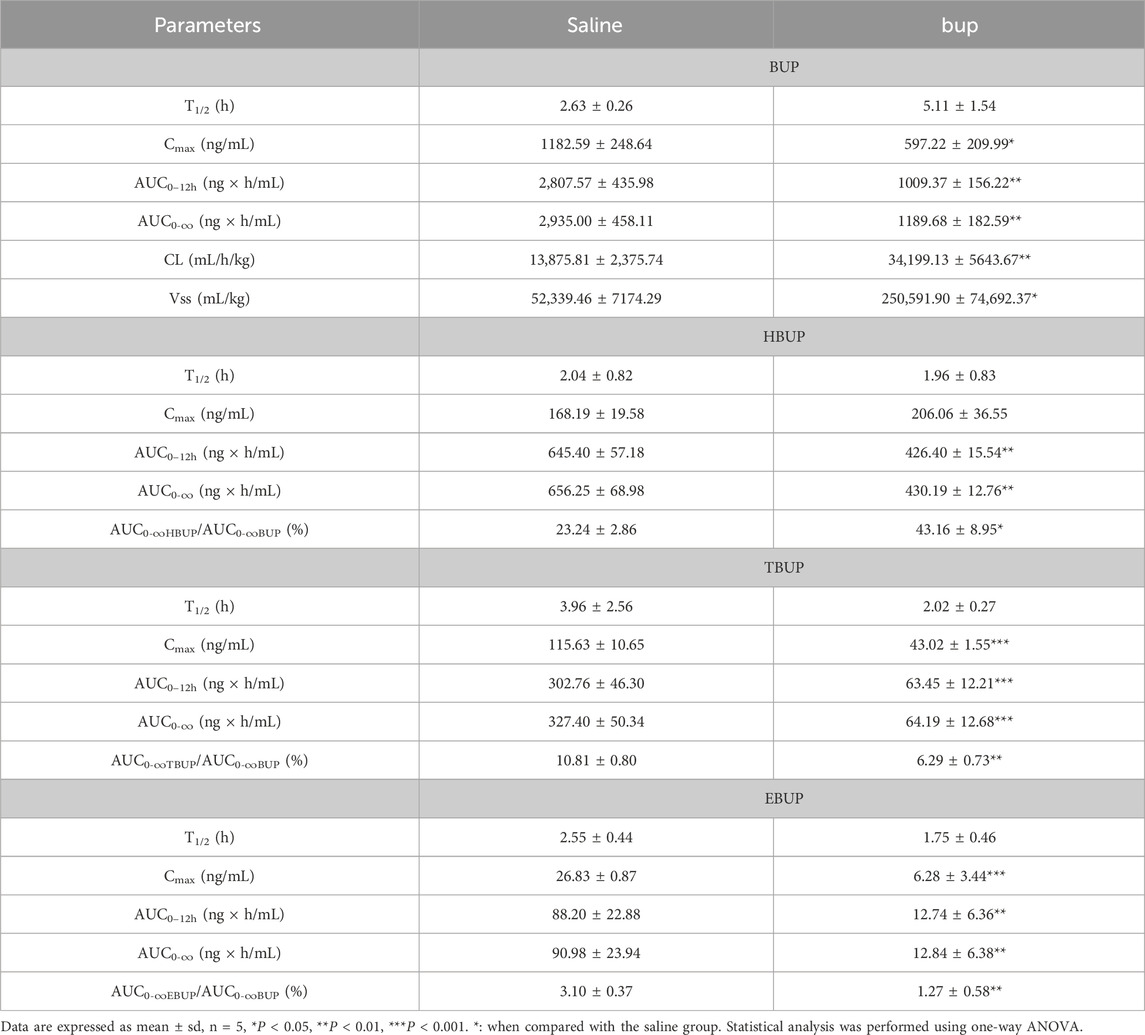- 1Department of Pharmacy, The 2nd affiliated hospital, Jiangxi Medical College, Nanchang University, Nanchang, Jiangxi, China
- 2Clinical Pharmacology Institute, School of Pharmacy, Jiangxi Medical College, Nanchang University, Nanchang, Jiangxi, China
- 3School of Pharmacy, Jiangxi Medical College, Nanchang University, Nanchang, Jiangxi, China
- 4Department of Nephrology, The 2nd affiliated hospital, Jiangxi Medical College, Nanchang University, Nanchang, Jiangxi, China
- 5Department of Pathology, The 2nd affiliated hospital, Jiangxi Medical College, Nanchang University, Nanchang, Jiangxi, China
- 6Clinical Pharmacokinetics Laboratory, School of Basic Medicine and Clinical Pharmacy, China Pharmaceutical University, Nanjing, China
Objective: The objective of the study was to investigate whether bupropion (BUP) or its circulation metabolites could decrease plasma level of asymmetric dimethylarginine (ADMA) and ameliorate renal injury by modulation of Ddah1, Oatp4c1, Oct2, and Mate1 in rats with adenine-induced chronic renal injury.
Methods: The study initially determined the effect of BUP and its metabolites on cell viability and apoptosis in HK2 cells in the presence and absence of ADMA. Secondly, the study explored whether long-term administration of BUP could reduce the plasma level of ADMA and mitigate renal damage. Thirdly, the expression and activity of Oct2, Ddah1, Mate1 and Oatp4c1 was determined by Western blot and UPLC-MS/MS.
Results: With 0.5 μmol/L ADMA, hydroxybupropion (HBUP, 100 nmol/L), threo-hydrobupropion (TBUP, 10 nmol/L and 1 μmol/L) reduced N-Acetyl-β-D-glucosidase (NAG) level. At 5 μmol/L ADMA, BUP (1 nmol/L-1 μmol/L), HBUP (1–100 nmol/L), and BUP cocktail enhanced survival. At 50 μmol/L ADMA, HBUP (10 nmol/L and 1 μmol/L), TBUP/erythro-hydrobupropion (EBUP) (10–100 nmol/L), and BUP cocktail stimulated survival. EBUP (1 and 100 nmol/L) lowered LDH. BUP (100 nmol/L) and TBUP (1 μmol/L) decreased NAG. TBUP (10 nmol/L, 1 μmol/L) and EBUP (100 nmol/L) inhibited apoptosis. In adenine-induced chronic renal injury rats, long-term administration of BUP significantly decreased the serum concentration of ADMA and creatinine by 12.78% and 38.85%, respectively, ameliorated interstitial lesions and fibrosis and upregulated Ddah1, Oatp4c1, Oct2, Mate1. BUP increased metformin renal clearance without affecting digoxin disposition.
Conclusion: Bupropion moderately decreases plasma levels of ADMA and ameliorates renal injury by modulation of Ddah1, Oatp4c1, Oct2, and Mate1.
Introduction
Chronic kidney disease (CKD), with an estimated prevalence of approximately 10.0% (95% confidence interval 8.5–11.4) worldwide, has emerged as a global public health challenge (Sundström et al., 2022; Guo et al., 2025). Epidemiological studies in China indicated that the prevalence of CKD among adults is 8.2% (Wang et al., 2023). The accumulation of various endogenous and exogenous compounds, particularly uremic toxins, trigger multiple comorbidities as CKD progresses (Lim et al., 2021). Moreover, the prevalence of depression among CKD patients adversely affects the quality of life and significantly increases the duration of hospitalization and mortality (Charles and Ferris, 2020; Naber and Purohit, 2021; Nagler et al., 2012).
Uremic toxins, lead to various degrees of cellular, tissue, and organ damage (Brunini et al., 2006; Chen and Chiang, 2021). They may also cause immune dysregulation, inflammatory injury, and metabolic disturbances (Brunini et al., 2006; Chen and Chiang, 2021). Asymmetric dimethylarginine (ADMA) is an amine toxin among small molecular uremic toxins and serves as an endogenous inhibitor of nitric oxide synthase. It induces oxidative stress responses and is involved in endothelial dysfunction, as well as the onset and progression of cardiovascular diseases in patients with CKD (Oliva-Damaso et al., 2019; Shafi et al., 2017; Strobel et al., 2013). Serum levels of ADMA are important biomarkers for CKD and are negatively correlated with residual renal function. In patients with end-stage renal disease, serum concentrations of ADMA increased by 4–10 times (Oliva-Damaso et al., 2019; Shafi et al., 2017).
The kidneys play a crucial role in the systematic elimination of ADMA. More than 80% ADMA is degraded by dimethylarginine dimethylaminohydrolase 1 (Ddah1) into citrulline and dimethylamine in proximal tubular epithelial cells, while symmetric dimethylarginine, the isomer of ADMA, is mainly excreted unchanged in the urine (Oliva-Damaso et al., 2019; Tain and Hsu, 2017; Guo et al., 2023). Strobel J et al. reported that ADMA is a substrate for both the basolateral organic cation transporter 2 (Oct2) and the apical multidrug and toxin extrusion protein 1 (Mate1) in renal tubular epithelial cells (STROBEL et al., 2013). Organic anion-transporting polypeptide 4c1 (Oatp4c1), the only Oatps expressed in the kidney, also involves ADMA renal excretion (Taghikhani et al., 2019; Yamaguchi et al., 2010; Mikkaichi et al., 2004; Toyohara et al., 2009). Rat Oatp4c1 traffics to the apical cell surface of polarized epithelium and localizes primarily in the proximal straight tubules, the S3 fraction of the nephron, facilitating substrate reabsorption (Toyohara et al., 2009; He et al., 2014). Both acute and chronic kidney failure alters the expression of Oct2, Mate1, and Oatp4c1, causing reduced renal clearance (CLrenal) of protein-bound toxins (Masereeuw et al., 2014; Schwenk and Pai, 2016; Naud et al., 2011). Toyohara T et al. found that modulation of Oatp4c1 expression and activity not only directly correlates with the CLrenal of protein-bound toxins, such as ADMA, transuranic acid, and guanidinosuccinic acid, but also improves kidney dysfunction related hypertension, myocardial hypertrophy and renal inflammatory responses (Toyohara et al., 2009).
Bupropion (BUP), a dopamine-norepinephrine reuptake inhibitor, is prescribed to treat major depressive disorder and to aid smoking cessation or obesity management (Greig and Keating, 2015; Cinciripini et al., 2017; Jefferson et al., 2005). It exhibits high safety profiles, with no significant cardiac or renal toxicity (Zyban, 2014). BUP undergoes extensive metabolism via Cytochrome P450 (CYP) 2B6 and carbonyl reductase to form active metabolites hydroxybupropion (HBUP), erythro-hydrobupropion (EBUP), and threo-hydrobupropion (TBUP) (Jefferson et al., 2005; Connarn et al., 2015). This process is followed by uridine diphosphate glycosyltransferase (UGT) 2B7 and UGT1A9 mediated stereoselective glucuronidation that produces various inactive glucuronide metabolites for excretion (Sager et al., 2016; Gufford et al., 2016). The fraction of unchanged BUP excreted in urine accounts for only 0.5%, while less than 1% is eliminated through feces (Khan et al., 2016). After long-term administration of BUP, the steady-state peak plasma concentration (Cmax) and the area under the plasma concentration time curve (AUC) for HBUP and TBUP were 4-, 7-fold, and 4-, 6-fold higher than those following single-dose of BUP, respectively (Costa et al., 2019; Benowitz et al., 2013). Mao et al. demonstrated that neither BUP nor its active metabolites were substrates for Oct1, Oatp1b1, Oatp1b3, Oatp2b1, Oatp4a1, breast cancer resistance protein (Bcrp), multidrug resistance-associated protein 2 (Mrp2) or P-glycoprotein (P-gp) (Han et al., 2019).
Our precious studies reported that at clinically relevant plasma concentrations, BUP and its metabolites activated human-OATP4C1 mediated digoxin (DIG) tubular secretion and inhibited rat-Oatp4c1-mediated DIG renal reabsorption (He et al., 2014). We also found that multiple-dosing of BUP significantly increased oral DIG CLrenal 0–48h and CLnon-renal0–48h in cynomolgus monkeys, suggesting the capability of transporter and enzyme modulation (Shen et al., 2018). Therefore, it is hypothesized that at clinically relevant plasma concentrations, BUP or its metabolites, modulated Oct2, Oatp4c1, and Mate1 mediated renal transport of ADMA and/or Ddah1 mediated metabolism, which could alleviate the exacerbation of ADMA and retard the progression of renal interstitial lesions and fibrosis.
To test this hypothesis, the study initially determined the effect of BUP and its metabolites on cell viability and apoptosis in HK2 cells both in the presence and absence of ADMA. Secondly, the study explored whether the long-term administration of BUP could reduce the plasma level of harmful uremic toxins such as ADMA and mitigate renal damage through histopathological examination in the chronic renal injury model in rats. Thirdly, the chronic effect of BUP and its metabolites on the expression of Oct2, Ddah1, Mate1 and Ddah1 was determined. The activity of the transporters, as measured by the pharmacokinetics of the probe drugs, was also evaluated using UPLC-MS/MS.
Materials and methods
Chemicals and reagents
BUP (purity >99.9%), HBUP (purity >99.9%), TBUP (purity >99.9%), EBUP (purity >99.9%), ADMA (purity >99.9%), metformin (MET, purity >99.9%) and furosemide (FUR, purity >99.9%) were purchased from National Standard Pharmaceutical Group Co., Ltd. (Beijing, China). Digoxin (DIG, purity >99.9%) were purchased from J&K Scientific Ltd. (Shanghai, China). Adenine (purity >99.5%) was purchased from Shanghai Aladdin Biochemical Technology Co., Ltd. (Shanghai, China). Rosuvastatin (RSV, purity >95.0%) was purchased from J&K Scientific Co., Ltd. (Shanghai, China). Diazepam (DIA, purity >99.0%) was purchased from Sigma Aldrich (St Louis, MO, United States). DIG injection (0.25 mg/mL) was purchased from Southwest Pharmaceutical Co., Ltd. (Chongqing, China). FUR injection (10 mg/mL) was purchased from Henan Runhong Pharmaceutical Co., Ltd. (Chongqing, China). Cell count kit-8 (CCK-8) was purchased from GLP Bio Co., Ltd. (Montclair, United States). Acridine Orange (AO)/ Ethidium Bromide (EB) double fluorescence staining kit was purchased from Phygene Biotechnology Co., Ltd. (Fuzhou China). Lactate dehydrogenase (LDH) assay kit, creatinine (Cre) assay kit, urea nitrogen (Bun) assay kit and albumin (Alb) assay kit were purchased from Nanjing Jiancheng Bioengineering Institute (Nanjing, China). N-Acetyl-β-D-glucosidase (NAG) activity assay kit was purchased from Solarbio Co., Ltd. (Beijing, China). ADMA elisa assay kit, kidney injury molecule-1 (Kim-1) elisa assay kit, cystatin-c (Cys-c) elisa assay kit, β2-MG elisa assay kit were purchased from Shanghai Jingkang Biotechnology Co., Ltd. (Shanghai, China). Antibodies against Oct2 (13594-1-AP), Mate1 (20898-1-AP), Oatp4c1 (24584-1-AP), and β-actin (20536-1-AP) were purchased from Wuhan Protech Biotechnology Co., Ltd. (Wuhan, China). Antibodies against Ddah1 (PB1052) was purchased from Boster Biotechnology Co., Ltd. (Wuhan, China).
Ethical approval
All experimental procedures were performed in accordance with the Institutional Guidelines for the Care and Use of Laboratory Animals and were approved by the Institutional Animal Care and Use Committee of Nanchang University in 2022 (Permit Number: NCULAE-20221031034). Humane end point:I. rats lost more than 20% of their normal animal body weight. II. rats were unable to take food or water. III. abnormal manifestations such as jaundice, excessive depression and self-harm in rats. In cases of hepatotoxicity, rats may exhibit symptoms such as jaundice, lethargy, reduced activity, weight loss and ruffled fur.
Cell culture
Human renal cortical proximal tubular epithelial cell (HK-2) was obtained from Procell Life Science & Technology Co., Ltd. (Wuhan, China). Cells were cultured in DMEM-F12 medium supplemented with 10% fetal bovine serum, 100 U/mL penicillin and 100 μg/mL streptomycin in the ratio of 100:10:1:1 at 37 °C in the presence of 5% CO2.
Cell counting Kit-8 (CCK8) assay
Cell viability was assessed by CCK8 assay according to the manufacturer’s protocols. Briefly, cells were seeded and cultured in 96-well plates at a density of 5 × 103/ well in 100 μL of medium. Then the cells were treated with varying concentrations of ADMA, BUP or its metabolites or BUP cocktail, and then incubated for 24 h at 37 °C. Then CCK-8 reagent was added to each well and then cultured for 2 h at 37 °C. The absorbance at 450 nm was measured using a multilabel reader (PerkinElmer EnSpire, United States). All experiments were performed in triplicate.
Acridine Orange/Ethidium Bromide (AO/EB) staining
Cell apoptosis was assessed by AO/EB dual staining according to the manufacturer’s protocol. Briefly, cells were grown in 96-well plates at a density of 5 × 103/ well in 100 μL of medium. Then the cells were treated with varying concentrations of ADMA, BUP, BUP metabolites or BUP cocktail, and then incubated for 24 h at 37 °C. Then a solution containing 2.5 μL AO and 2.5 μL EB was added to each well and then incubated for 5 min at 37 °C. Cell fluorescence was measured using an inverted fluorescence microscope (Olympus, Japan).
Biochemical examination in the culture medium and cell lysate
LDH activity in the culture medium and NAG activity in cell lysate was determined using LDH kit and NAG kit according to the manufacturer’s instructions, respectively.
Animals
Male Sprague-Dawley (SD) rats (200–220 g) were obtained from Hunan SJA Laboratory Animal Co., Ltd. (Changsha, China, No. SCXK<Xiang> 2019–0004). All 30 rats were kept at 12 h light and 12 h dark cycle with 50%–60% humidity at 25°C ± 2°C and given standard sterile food and water. Standard sterile food consists of crude protein (≥180 g/kg), crude fat (≥40 g/kg), crude fiber (≤50 g/kg), crude ash (≤80 g/kg), moisture and other volatile matter (≤100 g/kg), calcium (10–18 g/kg), total phosphorus (6–12 g/kg) as well as amino acids, vitamins and minerals. They were randomly assigned to respective experiment groups. Whenever overnight fasting was used before dosing, food was provided 2 h after dosing. All animal care and experimental procedures were conducted in accordance with the guidelines for the care and use of laboratory animals issued by NIH, and the animal experimental protocol was approved by the Ethics Committee of Nanchang University (NCULAE-20221031034).
Establishment of a chronic renal injury model in rats
Following 1 week of acclimatization, venous blood was collected to measure baseline plasma levels of creatinine (Cre) and blood urea nitrogen (Bun). A daily gavage of adenine suspension (200 mg/kg) was administered for a duration of 21 days (Yang et al., 2024). On day 22, venous blood samples were taken to assess Cre and Bun levels. Pathological observation of renal tissues was also conducted for model validation.
Animal study protocol
For the plasma pharmacokinetic study, 30 rats with chronic renal injury were randomly assigned into six groups (n = 5, each group, groups I to VI) and received oral gavage (p.o) of BUP (40 mg/kg) or an equivalent volume of physiological saline as vehicle control for 27 days. On day 28, rats in group I were treated with a p.o. dose of vehicle control. Rats in group II were treated with a p.o. dose of BUP at 40 mg/kg. Rats in group Ⅲ were treated with a p.o. dose of vehicle control and a single intravenous (i.v.) dose of DIG at 0.005 mg/kg. Rats in group Ⅳ were treated with a p.o. dose of BUP at 40 mg/kg of and a single i.v. dose of DIG at 0.005 mg/kg. Rats in group V were treated with a p.o. dose of vehicle control and a probe drug cocktail (a single i.v. dose of MET at 5 mg/kg, a single i.v. dose of FUR at 4 mg/kg and a single p.o. dose of RSV at 25 mg/kg). Rats in group VI were treated with a p.o. dose of BUP at 40 mg/kg of and the same probe drug cocktail Blood samples were collected at 0, 5, 10, 30, 60, 120, 180, 360, 480 and 720 min in group I-II, and at 0, 2, 5, 15, 30, 60, 120, 240, 360, 480, 600, and 720 min in group III-VI (0.1 mL each for the first two time points and 0.2 mL each for the remaining time points). After each sampling, a volume of 0.2 mL physiologic saline solutions was administered to sustain isotonic fluid balance. Blood samples were centrifuged for plasma collection at 3,000 rpm for 10 min at 4°C. Urine samples were collected at 0–6 h and 6–12 h though metabolic cages. All samples were stored at −80°C until analysis by reagent kit and UPLC-MS/MS.
Biochemical examination and histopathology in rats
After the last sample in the plasma pharmacokinetic study, all rats were deeply anesthetized using an anesthetic agent, 50 mg/kg of sodium pentobarbital (ip), as a chemical method of euthanasia, and exsanguinated by severing the abdominal aorta. Blood and kidney samples were harvested. The plasma samples were used for the assay of ADMA, Kim-1, Cys-C, β2-MG, Cre, Bun and Alb according to the manufacturer’s instructions, respectively. The urine samples were used for the assay of ADMA, Kim-1, β2-MG and Cre according to the manufacturer’s instructions, respectively. Kidney specimens were fixed in 4% paraformaldehyde for 2–3 days and passed through the routine paraffin embedding procedures. They were serially sectioned and stained with hematoxylin and eosin, masson, and sirius red for histological evaluations.
Western blot analysis
Total proteins were extracted from kidney tissues using radio immunoprecipitation assay lysis (RIPA) buffer supplemented with phenylmethanesulfonyl fluoride (PMSF). Samples were then separated on 10% SDS-polyacrylamide gels and subsequently transferred to polyvinylidene difluoride (PVDF) membranes via electroblotting. The membranes were blocked with 5% skim milk powder for 2 h and incubated overnight at 4 °C with the appropriate primary antibody, followed by a 1 h incubation at room temperature with a secondary antibody conjugated to horseradish peroxidase (HRP). The reaction products were visualized through chemiluminescence detection utilizing the enhanced chemiluminescence (ECL) Protein Blotting Detection System. Quantification of the results was performed using ImageJ software.
Plasma and urine analysis
Biological sample preparation and analysis were performed according to our previous established method with minor modification (He et al., 2014; Shen et al., 2018; Huang et al., 2025). A Shimadzu Nexera liquid chromatography system (Shimadzu, Kyoto, Japan) and an 8050 CL triple quadruple tandem mass spectrometer (Shimadzu, Kyoto, Japan) coupled with an electro-spray ionization (ESI) source was used for the LC-MS/MS analysis of the plasma and urine samples.
Chromatographic separation was conducted at 40 °C with a gradient mobile phase programme to separate BUP, HBUP, EBUP, TBUP, DIG and diazepam (DIA, internal standard) on a Shimadzu Shim-pack Gist-C18 2.0 μm (2.1 × 100 mm; Shimadzu, Japan) analytical column. The mobile phase consisted of water (A), containing 0.1% formic acid containing 5 mM ammonium formate, and methanol (B). The flow rate was 0.4 mL/min and the mobile phase was run using the following gradient programme (B concentration in parentheses): 0.02–2 min (37%–40%), 2.0–6.0 min (40%–65%), 6.0–7.0 min (65%–95%), 7.0–8.0 min (95%), 8.0–8.01 min (95%–40%) and 8.02–10.0 min (37%). The injection volume was 3 μL.
Chromatographic separation was conducted at 30 °C with a gradient mobile phase programme to separate MET, RSV, FUR and DIA (internal standard) on a Shimadzu Shim-pack Gist-C18 3.0 μm (2.1 × 100 mm; Shimadzu, Japan) analytical column. The flow rate was 0.4 mL/min and the mobile phase was run using the following gradient programme (B concentration in parentheses): 0.8 min (1%), 0.8–0.9 min (1%–35%), 0.9–6.0 min (35%–60%), 6.0–6.5 min (60%–95%), 6.5–7.5 min (95%), 7.5–7.6 min (95%–1%) and 7.6–9.0 min (1%). The injection volume was 5 μL.
The following multiple reaction monitoring (MRM) transitions were used: BUP, m/z 239.9→166.05; HBUP, m/z 256.1→167.1; EBUP/TBUP, m/z 242.0→168.2; DIG, m/z 825.4→649.35; MET, 130.20 → 60.20; RSV, 482.00→258.15; FUR, 329.00→205.05; DIA, m/z 285.1→154.1.
Pharmacokinetic analysis
Phoenix® WinNonlin® version 8.1 software (Pharsight Corporation, Mountain View, CA) was used to calculate the pharmacokinetic parameters in rats by the non-compartmental method. The Cmax and time to reach Cmax (Tmax) were obtained directly from the plasma concentration time profile. The AUC was estimated by the trapezoidal rule. CLrenal was calculated as the excreted amount in 12 h urine collections divided by the plasma AUC0–12h (Shen et al., 2018). Creatinine clearance (CLcr) was calculated from the following formula: CLcr = Urinecr × V/Plasmacr and expressed in mL/h, where Urinecr = urine concentration of Cr; V = urine flow rate (mL/h); Plasmacr = plasma concentration of Cr (Shen et al., 2018). Renal clearance of ADMA (CLrenal ADMA) was calculated accordingly.
Statistical analysis
Statistical analyses were performed using GraphPad Prism 8.0 (GraphPad Software, San Diego, CA, United States). The results are presented as mean ± standard deviation (S.D.), unless otherwise stated. As for sample size justification, by assuming comparing the renal clearance of two groups, α = 0. 05, β = 0.10, Z = 1.96, σ = 4.4979 (He et al., 2014), E = 4, n1 = n2 = Z2×σ2/E2 = 5 for each group in the in vivo experiments. Taking together the 3R principle (reduction, refinement and replacement) and animal welfare of experimental animals, five animals were selected. Additionally, by assuming comparing two groups of cell viability, α = 0. 05, β = 0.10, Z = 1.96, σ = 35.3479 (obtained from previous pilot study), E = 40, n1 = n2 = = Z2×σ2/E2 = 3 for each group in the in vitro experiments. In addition, the same sample size was adopted for in-vitro and in-vivo study in our previous study (He et al., 2014).
Pharmacokinetic parameters, such as area under the plasma concentration-time curve (AUC), Cmax and clearance (CL), were log-transformed to fit a normal distribution. After testing for homogeneity of variance, statistical analysis was performed using one-way ANOVA followed by LSD post hoc test or Dunnett’s T3 post hoc test. Nonparametric statistics (Kruskal–Wallis one-way analysis) were used if the data were not normally distributed, such as terminal half-life (T1/2) and Tmax. A probability (p) of less than 0.05 was statistically significant.
Results
Cytotoxicity in HK2 cells
Dose-dependent cytotoxicity of ADMA was observed in HK2 cells after 24 h incubation (Figures 1A, 2A).
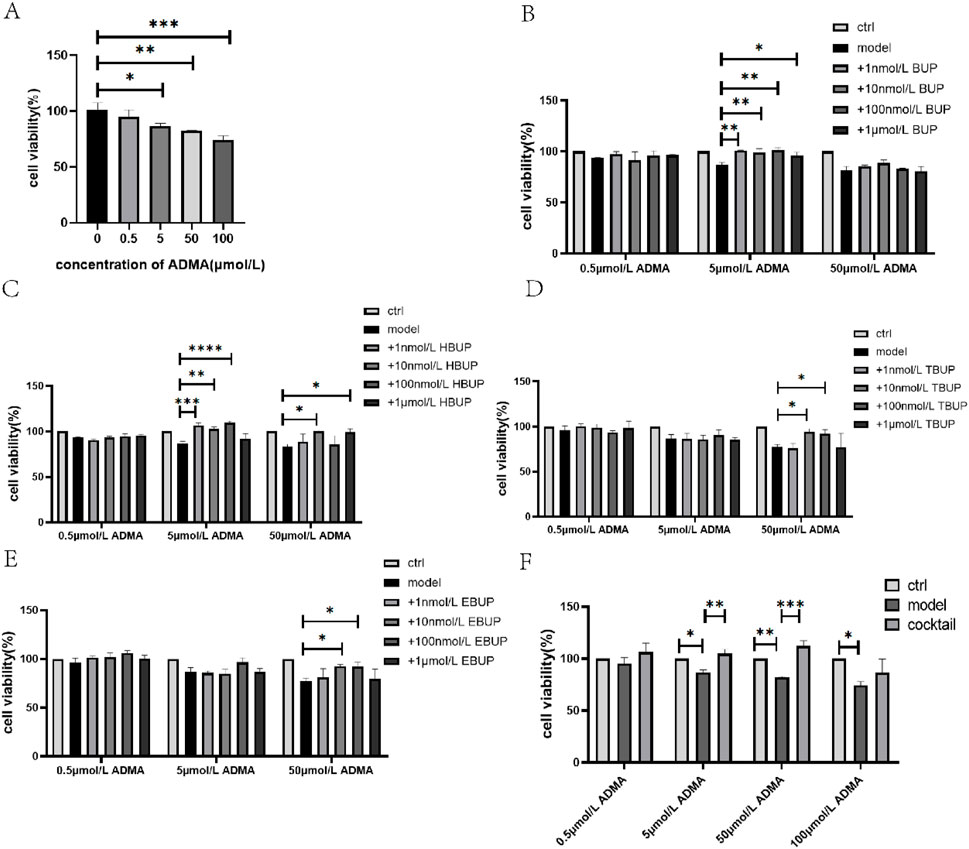
Figure 1. HK2 cell survival in the presence of ADMA (A), BUP (B), HBUP (C), TBUP (D), EBUP (E) or BUP cocktail (F). Ctrl means normal cell group. BUP cocktail consisted of 15 nmol/L BUP+125 nmol/L HBUP+50 nmol/L EBUP+50 nmol/L TBUP. Data are expressed as mean ± SD (n = 3). *P < 0.05, **P < 0.01, ***P < 0.001, ****P < 0.0001. Data were analyzed by one-way ANOVA.
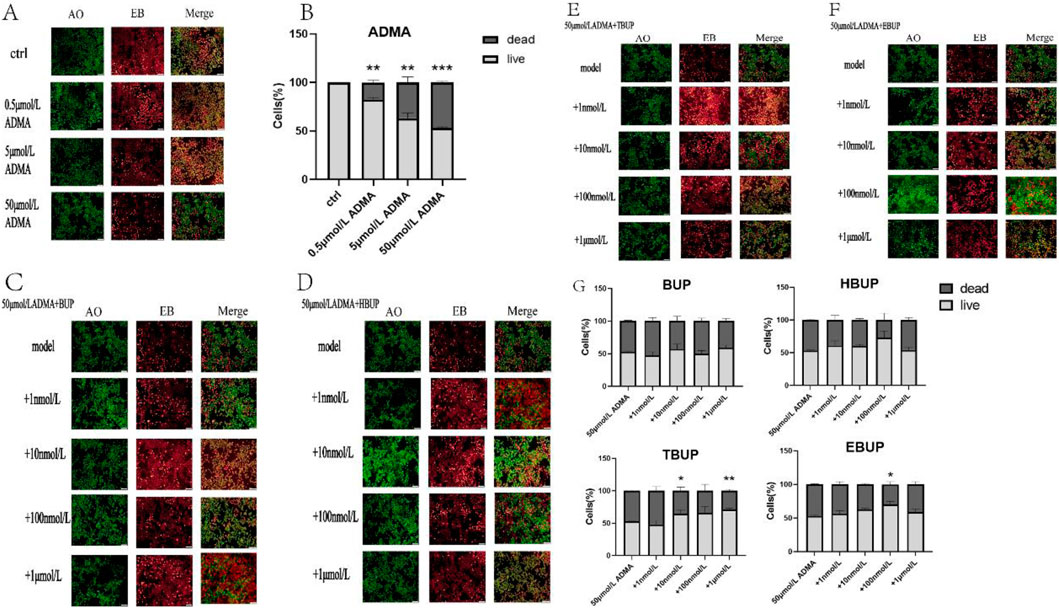
Figure 2. Cell apoptosis with AO/EB staining. (A,B) different concentrations of ADMA; (C–G) 50 μmol/L ADMA + BUP/HBUP/TBUP/EBUP. Ctrl means normal cell group. *: compared with the first column of each panel. Data are expressed as mean ± SD (n = 3). *P < 0.05, **P < 0.01, ***P < 0.001. Data were analyzed by one-way ANOVA.
In the presence of 0.5 μmol/L ADMA, BUP, BUP metabolites and BUP cocktail did not affect cell proliferation during incubation (Figures 1B–F).
In the presence of 5 μmol/L ADMA, BUP (1 nmol/L-1 μmol/L) and its major metabolite, HBUP (1 nmol/L-100 nmol/L), significantly stimulated cell survival. BUP cocktail also significantly stimulated cell survival by 20.96% (Figures 1B–F).
Moreover, in the presence of 50 μmol/L ADMA, HBUP at 10 nmol/L and 1 μmol/L, TBUP at 10 nmol/L and100 nmol/L, EBUP at 10 nmol/L and100 nmol/L and BUP cocktail significantly stimulated cell survival by 17.32%, 16.09%, 17.10%, 14.96%, 15.51%, 15.33%, and 36.33%, respectively (Figures 1B–F). Additionally, the administration of 10 nmol/L and 1 μmol/L TBUP, as well as 100 nmol/L EBUP, effectively mitigated cellular apoptosis (Figure 2G).
The effect of BUP and its metabolites on the biomarkers in the culture medium and cell lysate
In the presence of 0.5 μmol/L ADMA, BUP, BUP metabolites and BUP cocktail had no effect on LDH level in cell culture supernatant (Figure 3A). 100 nmol/L HBUP, 10 nmol/L and1 μmol/L TBUP significantly reduced NAG level by 41.61%, 55.45% and 15.74%, respectively (Figure 3B). However, 100 nmol/L BUP significantly increased NAG by 30.33% (Figure 3B).
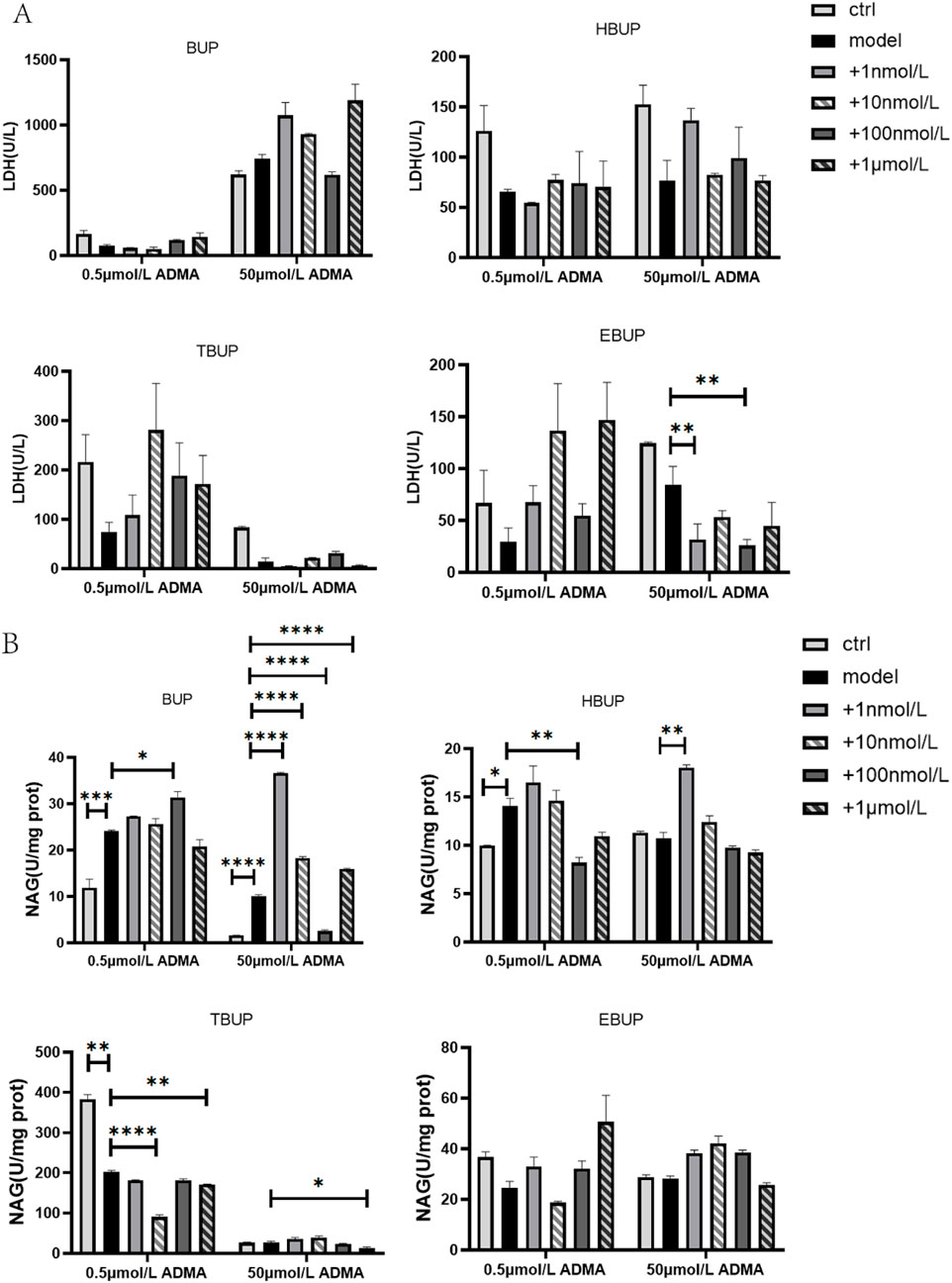
Figure 3. The effect of BUP and BUP metabolites on LDH (A) and NAG (B) in the culture medium and cell lysate. Ctrl means normal cell group. Data are expressed as mean ± SD (n = 3). *P < 0.05, **P < 0.01, ***P < 0.001, ****P < 0.0001. Data were analyzed by one-way ANOVA.
In the presence of 50 μmol/L ADMA, 1 nmol/L and 100 nmol/L of EBUP significantly reduced LDH level by 62.63% and 69.36%, respectively (Figure 3A). 100 nmol/L BUP and1 μmol/L TBUP significantly reduced NAG by 74.75 % and 52.20%, respectively (Figure 3B).
BUP cocktail had no effect on LDH and NAG level in the presence of 0.5 μmol/L and 50 μmol/L ADMA, respectively (Figure 4).

Figure 4. The effect of BUP cocktail on LDH (A) and NAG (B) in the culture medium and cell lysate. Ctrl means normal cell group. BUP cocktail consisted of 15 nmol/L BUP+125 nmol/L HBUP+50 nmol/L EBUP+50 nmol/L TBUP. Data are expressed as mean ± SD (n = 3). Data were analyzed by one-way ANOVA.
Establishment of rat model with adenine-induced chronic renal injury
Successful re-produce of the model is indicated by an increase in Cre levels exceeding 180 μmol/L, Bun levels surpassing 50 mmol/L, and histopathological analysis in the kidney tissue sections (Shabaka et al., 2021; Sharp and Brown, 2024).
After 21 days of gavage with adenine, the serum Cre and Bun significantly elevated by 539.80% and 962.43%, respectively (Supplementary Figure S1A). Histological patterns of the kidney exhibited interstitial lesions and necrosis of the renal tubules, which suggested the chronic renal injury models were replicated. (Supplementary Figure S1B).
The effect of BUP on the biomarkers of serum and urine in rats with chronic renal injury
In rats with chronic renal injury, long-term administration of BUP significantly reduced serum concentration of ADMA and Cre by 12.78% (P = 0.036) and 38.85% (P = 0.019), respectively, but did not significantly affect the plasma concentrations of Cys-c, β2-MG, Kim-1, Bun and Alb (Figures 5A,B).

Figure 5. The effects of BUP on Cre, Bun, Alb (A) and ADMA, Cys-c, Kim-1, β2-MG (B) of plasma in renal injury rats. Data are expressed as mean ± SD (n = 5). *P < 0.05, **P < 0.01, ***P < 0.001, ****P < 0.0001. Data were analyzed by one-way ANOVA.
Trends of increase in the cumulative amount of ADMA and Cre excreted in urine were observed in the presence of BUP, while they missed statistical significance (Figure 6A). Additionally, the CLrenal of ADMA and Cre increased by 35.04% and 114.60%, respectively, but they failed to elicit significant changes (Figure 6B).
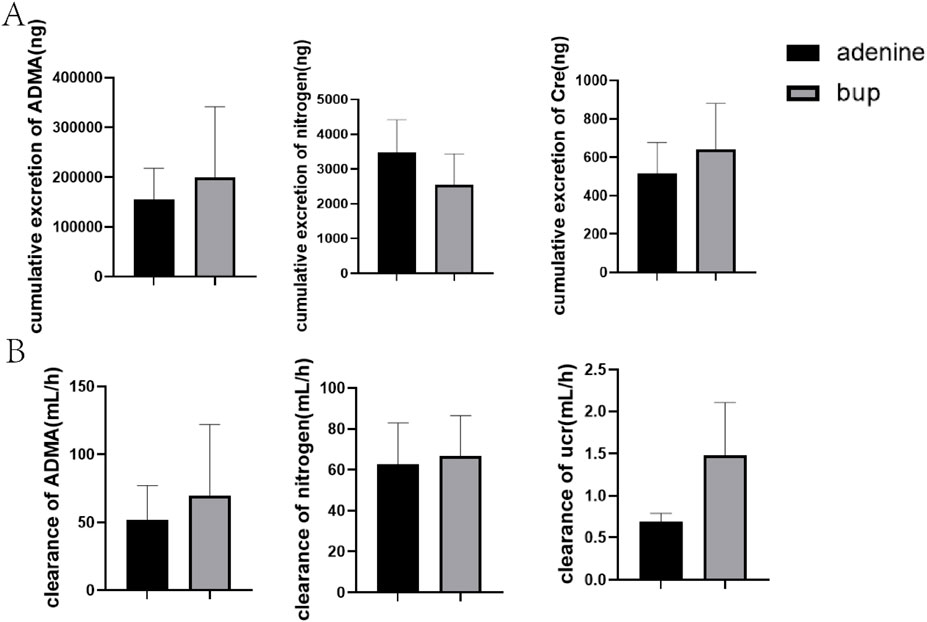
Figure 6. Effects of BUP on urea cumulative excretion (A) and urea clearance (B) of ADMA, nitrogen and Cre in renal injury rats. Data are expressed as mean ± SD (n = 5). *P < 0.05, **P < 0.01, ***P < 0.001, ****P < 0.0001. Data were analyzed by one-way ANOVA.
Histopathology
Compared with the control group, rats with chronic renal injury group presented with tubular atrophy and necrosis, severe interstitial fibrosis, and the confluence of fibrotic areas. After long-term administration of BUP, there was almost no tubular necrosis. Fibrosis was ameliorated, and the tubular basement membrane was slightly thickened (Figure 7).
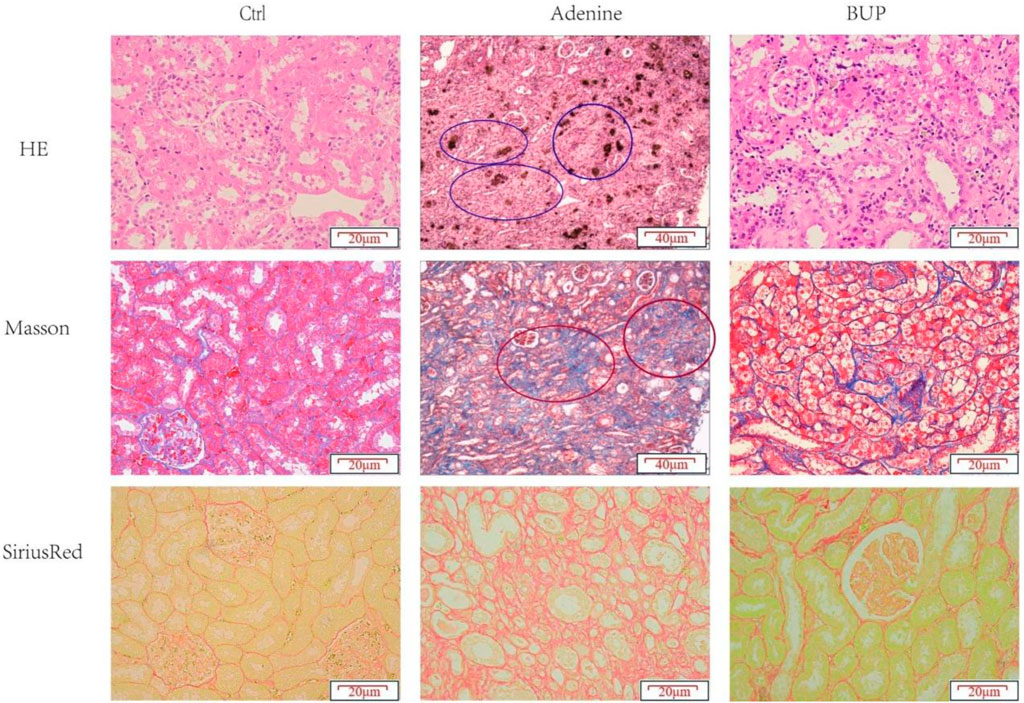
Figure 7. Histopathological evaluation of rat kidney tissue of different groups. Blue circle: tubular atrophy; red circle: interstitial fibrosis.
The effect of BUP on the expression of Oct2, Ddah1, Oatp4c1 and Mate1
The total protein was extracted from kidney tissue homogenate, and the protein concentrations were determined. The protein expression level of Ddah1, Oatp4c1, Oct2, and Mate1was significantly reduced by 75.50% (P < 0.0001), 62.09% (P < 0.0001) and 78.79% (P < 0.0001), respectively, in chronic renal injury rats (Figure 8). However, long-term administration of BUP significantly increased the protein expression of Ddah1, Oatp4c1, Oct2 and Mate1 by 43.59% (P < 0.0001), 42.50% (P < 0. 0.0001), 41.94% (P < 0. 001) and 46.55% (P < 0. 001), respectively (Figure 8).
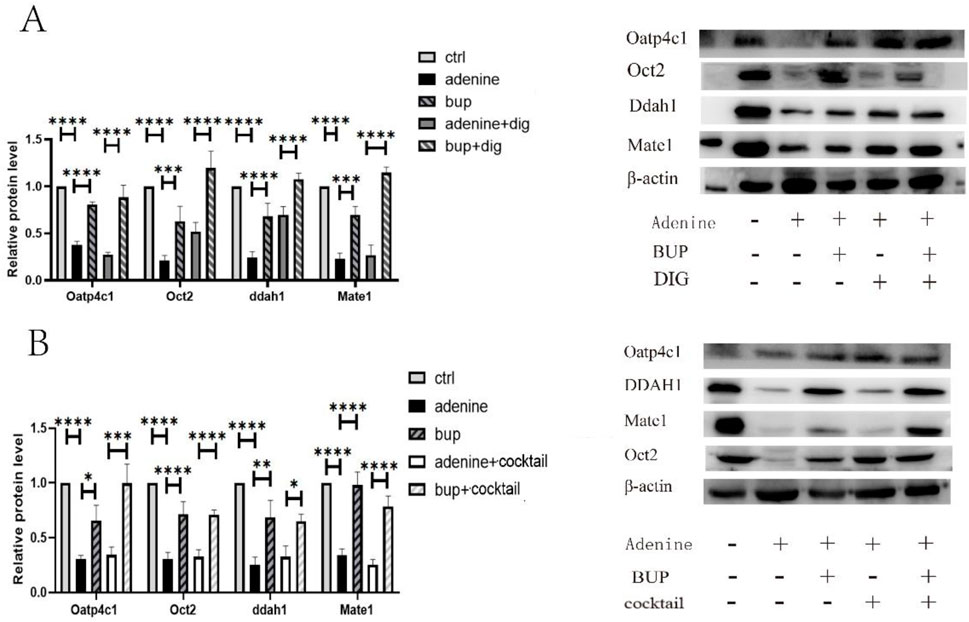
Figure 8. The protein expression of Oatp4c1, Oct2, Ddah1and Mate1 in rat kidney. (A) Long-term administration of BUP and followed by single-dose administration of DIG; (B) Long-term administration of BUP and followed by single-dose administration of drug cocktail. Cocktail consisted of a single i.v. dose of MET at 5 mg/kg, a single i.v. dose of FUR at 4 mg/kg and a single p.o. dose of RSV at 25 mg/kg. Data are expressed as mean ± SD (n = 5). *P < 0.05, **P < 0.01, ***P < 0.001, ****P < 0.0001. Data were analyzed by one-way ANOVA.
Additionally, long-term administration of BUP followed by a single dose of DIG resulted in a significant increase in the protein expression of Ddah1, Oatp4c1, Oct2, and Mate1, with upregulation by 37.9% (P < 0.0001), 60.8% (P < 0.0001), 67.65% (P < 0.0001), and 87.6% (P < 0.0001), respectively (Figure 8A). Similarly, after long-term administration of BUP followed by a single dose of MET, there was also a notable increase in the protein expression levels of Ddah1, Oatp4c1, Oct2, and Mate1, which was upregulated by 32.5% (P < 0.05), 65.3% (P < 0.001), 38.14% (P < 0.0001), and 53.07% (P < 0.0001), respectively (Figure 8B).
Effects of BUP on DIG pharmacokinetics in rats with chronic renal injury
The plasma concentration after intravenous administration of DIG decayed rapidly and biphasically in the presence and absence of BUP (Table 1; Figure 9A). Long-term administration of BUP followed by a single dose of DIG did not significantly affect the systemic plasma concentration, terminal plasma t1/2, plasma AUC, Cmax, volume of distribution at steady-state (Vss), or total CL of DIG (Table 1; Figure 9A). Although cumulative amount excreted in urine and CLrenal of DIG were increased by 82.41% and 70.38%, respectively, they failed to elicit significant changes (Table 1; Figure 9A).
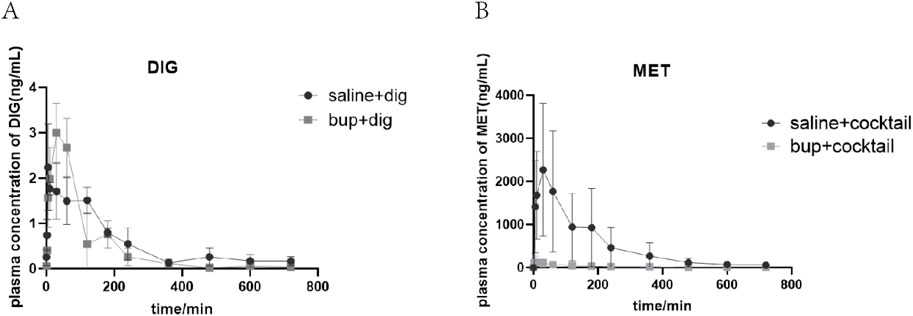
Figure 9. Mean plasma concentration-time profiles of DIG (A) and MET (B). Cocktail consisted of a single i.v. dose of MET at 5 mg/kg, a single i.v. dose of FUR at 4 mg/kg and a single p.o. dose of RSV at 25 mg/kg. Data are expressed as mean ± SD (n = 5).
Effects of BUP on MET pharmacokinetics in rats with chronic renal injury
The plasma concentration after intravenous administration of MET decayed rapidly in the presence of BUP (Table 2; Figure 9B). Long-term administration of BUP followed by a single dose of MET significantly decreased AUC0–12h by 90.35% (P = 0.0045) and increased CLrenal by 133.52% (P = 0.033) (Table 2; Figure 9B). A 615.73% increase in CL, a 2085.67% increase in Vss, and a 66.48% decrease in Cmax were also observed; however, these changes did not reach statistical significance (Table 2; Figure 9B).
Pharmacokinetics of BUP in rats with chronic renal injury
The pharmacokinetic parameters and plasma concentration time profiles of BUP and its circulating metabolites were presented in Table 3 and Figure 10, respectively. Long-term administration of BUP significantly decreased Cmax, AUC0–12h, AUC0-∞, Vss by 49.50% (P = 0.0357), 64.05% (P = 0.0025), 59.46% (P = 0.0036) and 378.78% (P = 0.01), respectively, and significantly increased CL by 146.47% (P = 0.0045). Similarly, long-term administration of BUP significantly altered the systematic disposition of its circulating metabolites. The AUC0–12h and AUC0-∞ of HBUP was significantly reduced by 33.93% (P = 0.0031) and 34.45% (P = 0.0051), respectively. AUC0-∞HBUP/AUC0-∞BUP was increased by 85.69% (P = 0.0213). The Cmax, AUC0–12h, AUC0-∞ and AUC0-∞TBUP/AUC0-∞BUP of TBUP was significantly decreased by 62.79% (P = 0.0003), 79.04% (P = 0.0010), 80.39% (P = 0.0009) and 41.78% (P = 0.0019), respectively. The Cmax, AUC0–12h, AUC0-∞ and AUC0-∞EBUP/AUC0-∞BUP of EBUP was significantly decreased by 76.59% (P = 0.0006), 85.55% (P = 0.0053), 85.88% (P = 0.0055) and 59.07% (P = 0.0097), respectively.
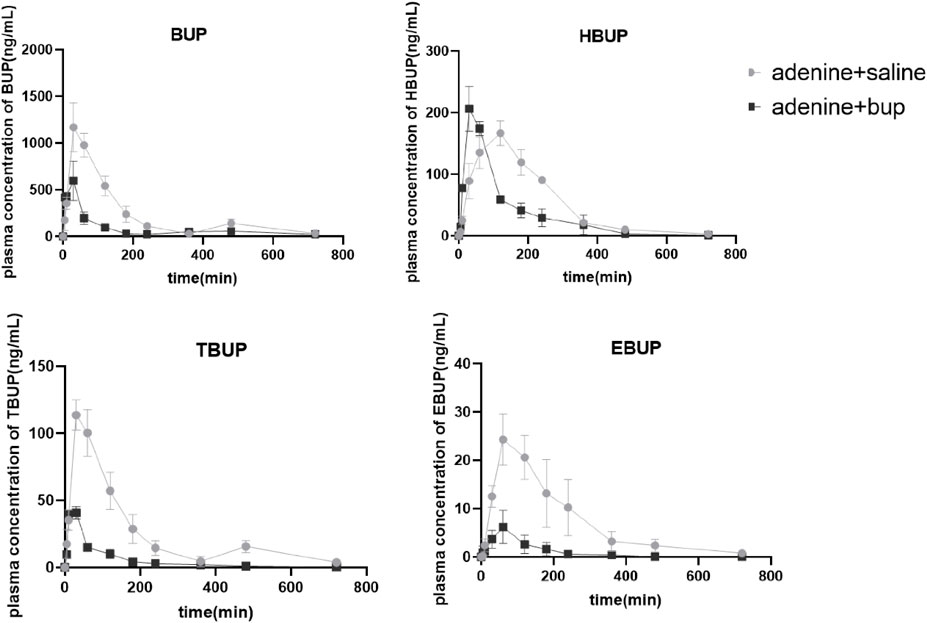
Figure 10. Mean plasma concentration-time profiles of BUP, HBUP, TBUP and EBUP. Data are expressed as mean ± SD (n = 5).
Discussion
CKD has emerged as a growing global health concern. Depression is considered as one of the most prevalent comorbid psychiatric conditions that occur in patients living with CKD, resulting in a complex interaction that can be detrimental to patient outcomes (Sharp and Brown, 2024). Palmer S et al. reported the prevalence of interview-based depression in people with CKD who require dialysis treatment (CKD stage 5D) was 22.8%, and 21.4% for patients with CKD stages 1–5 in a systematic review (Palmer et al., 2013). Recent studies have shown that 22.0% of patients had depression (stage 4 = 23.8%, stage 5 = 36.8%) in a Moroccan cross-sectional study or even higher as 58.3% in a cross-sectional study at the Jordan University Hospital (Alaoui et al., 2024; Alshelleh et al., 2022). Duan D et al. found that the prevalence of depression was 22.2% in Chinese patients with CKD without dialysis (Duan et al., 2021). Additionally, Chinese cohort study of CKD (C-STRIDE) revealed that the prevalence of depressive symptoms was 37. 8% and increased significantly with CKD stage (Pu et al., 2020). Therefore, it is critical to treat depression in the context of CKD to maximize patient outcomes. However, it remains controversial whether existing pharmacologic interventions are effective for treatment of depression in patients with CKD and end-stage kidney disease (Gregg and Hedayati, 2020). Therefore, there is a growing demand for safer and more innovative antidepressant therapies that not only enhance the effectiveness of depression treatments but also alleviate renal injury in patients with CKD.
BUP, a dopamine-norepinephrine reuptake inhibitor, remains a safe and effective antidepressant and is suitable for first-line use. Dose reduction of bupropion is recommended in patients with CKD3-5 (Nagler et al., 2012). BUP itself undergoes extensive stereoselective metabolism and glucuronidation. Our previous studies have also reported that HBUP, EBUP and TBUP were its major and most abundant circulation metabolites (He et al., 2014; Shen et al., 2018). HBUP, TBUP and EBUP, reach higher plasma concentrations than BUP in human (Costa et al., 2019). After long-term administration of BUP, the steady-state Cmax and AUC for HBUP and TBUP were 4-, 7-fold, and 4-, 6-fold higher than those following single-dose of BUP, respectively (Costa et al., 2019; Benowitz et al., 2013). HBUP has a longer elimination half-life than BUP (Jefferson et al., 2005). The metabolite potency, relative to BUP, is estimated to be 50%, 20%, and 20% for HBUP, TBUP, and EBUP, respectively. In this context, BUP metabolites are likely to play a very important role in the pharmacological and toxicological effects of the parent drug. The kidney is responsible for 87% bupropion excretion. Our previous studies suggested that the capacity for transporter and enzyme modulation following the administration of BUP in rats and in cynomolgus monkeys (He et al., 2014; Shen et al., 2018). Mao et al. demonstrated that neither BUP nor its active metabolites were substrates for OCT1, OATP1B1, OATP1B3, OATP2B1, OATP4A1, BCRP, MRP2 or P-gp (Han et al., 2019). BUP, HBUP and BUP cocktail (BUP plus its metabolites) significantly stimulated OATP4C1 mediated transport of [3H]-DIG, but had no effect on P-gp mediated transepithelial transport of [3H]-DIG, (He et al., 2014). However, little is known about their activity at relevant targets (e.g., Ddah1, Oct2, and Mate1). Therefore, BUP and its major circulation metabolites (HBUP, TBUP, EBUP) were chosen.
It is widely recognized that serum levels of asymmetric dimethylarginine (ADMA), a uremic toxin, are significant biomarkers for CKD (Oliva-Damaso et al., 2019; Shafi et al., 2017). Oct2, Mate1, Oatp4c1, and Ddah1 are involved in the renal disposition of ADMA (Strobel et al., 2013). Therefore, it is hypothesized that at clinically relevant plasma concentrations, BUP or its metabolites, modulated Oct2, Oatp4c1 and Mate1 mediated renal transport of ADMA and/or Ddah1 mediated metabolism, which could alleviate the exacerbation of ADMA and retard the progression of renal interstitial lesions and fibrosis.
In healthy serum, the concentration of ADMA is between 0.4 and 0.6 μmol/L (Horowitz and Heresztyn, 2007). In patients with end-stage renal disease, serum concentrations of ADMA increased by 4–10 times and varied a lot (Oliva-Damaso et al., 2019; Shafi et al., 2017). ADMA concentrations were 6.0 ± 0.5 μmol/L and 7.31 ± 0.70 μmol/L in predialysis hemodialysis-treated patients and in hemodialysis-treated patients with manifest atherosclerotic disease, respectively (Kielstein et al., 1999). The ADMA concentrations can be as high as 238.33 ± 16.19 μmol/L in predialysis hemodialysis-treated renal failure patients in samples provided by department of nephrology (n = 8, data not shown). In human endothelial cells, ADMA (0.1 μmol/L to 100 μmol/L) were used to test the inhibition effect on NO formation (Böger et al., 2000). Previous study suggested that intracellular ADMA levels were about 10-fold higher than the reported range for plasma values (Böger et al., 2000). Therefore, a range of ADMA concentrations (0.5 μmol/L, 5 μmol/L, 50 μmol/L) were selected in vitro experiments. The presence of 5 and 50 μmol/L ADMA is to mimic pathological conditions. We found ADMA suppressed cell proliferation and promoted cellular apoptosis in HK2 cells in a concentration-dependent manner. Interestingly, under physiological concentration of 0.5 μmol/L ADMA, BUP, BUP metabolites and BUP cocktail had no effect on cellular proliferation and apoptosis. In healthy subjects and adolescents, the concentration range of BUP, HBUP, EBUP plus TBUP are around 0.02–0.6 μmol/L, 0.1–1.68 μmol/L, 0.07–0.56 μmol/L, respectively (Chen et al., 2019; Tsikas, 2020). In smoking haemodialysis patients, the Cmax of BUP, HBUP, TBUP are 0.38–0.67μM, 1.07–3.04 μmol/L,0.28–1.09 μmol/L, respectively (Worrall et al., 2004). A significant accumulation of BUP metabolites can be observed in smokers with end stage renal disease. The fraction of BUP, HBUP and TBUP unbound in healthy human plasma is ∼0.16, 0.23, 0.58, respectively (Oliva-Damaso et al., 2019; Shafi et al., 2017). Assuming the same unbound fraction, the clinically relevant unbound Cmax of BUP, HBUP, TBUP in smoking haemodialysis patients are estimated to be 60.8 nmol/L −0.11 μmol/L, 0.25–0.70 μmol/L, 0.16–0.63 μmol/L, respectively. As was hypothesized, BUP and its major circulating metabolite stimulated cell survival in the clinically relevant plasma concentration range (1 nmol/L −1 μmol/L for BUP and 1 nmol/L −100 nmol/L for HBUP) in the presence of 5 μmol/L ADMA. However, only BUP metabolites stimulated cell survival in the clinically relevant plasma concentration range (HBUP at 10 nmol/L and 1 μmol/L for HBUP, 10 nmol/L and 100 nmol/L for TBUP and EBUP, respectively) in the presence of 50 μmol/L ADMA. Moreover, at clinically relevant concentrations, BUP cocktail, consisted of 15 nmol/L BUP, 125 nmol/L HBUP, 50 nmol/L EBUP and 50 nmol/L TBUP, stimulated cell survival in the presence of 5 and 50 μmol/L ADMA. This stimulation modestly reversed the inhibition caused at 5 and 50 μmol/L of ADMA.
NAG, a specific marker for tubular injury and possibly function, were measured (Bosomworth et al., 1999). LDH is an indicator of cellular damage. At physiological concentration, BUP, BUP metabolites and BUP cocktail did not affect cellular injury, as accessed by release of LDH in the culture medium. 100 nmol/L HBUP, 10 nmol/L and1 μmol/L TBUP exhibited protective effects. However, the increase in NAG in the presence of 100 nmol/L BUP was a surprise. At 50 μmol/L ADMA, BUP metabolites, especially 1 nmol/L and 100 nmol/L of EBUP and 1 μmol/L TBUP attenuated cellular damage. It appears that BUP and its metabolites may exert “pleiotropic” effects, with their efficacy in mitigating ADMA-related damage to HK2 cells being contingent upon the exposure of ADMA as well as the concentrations of BUP and its active metabolites.
To further elucidate the mechanisms of protective effect of BUP and its active metabolites in detail, we asked whether a pre-clinical animal model, such as the chronic renal injury rat, could replicate the observation in vitro. The adenine-induced CKD model is a well-established model, and it provides certain advantages and limitations (Han et al., 2019; Diwan et al., 2018). Firstly, daily gavage of adenine is simple and rat-friendly. Secondly, this intervention mimics most of the structural and functional changes seen in human CKD, such as renal crystallization and tubulointerstitial fibrosis (HAN et al., 2019; Diwan et al., 2018). Adenine increased serum Bun and Cre concentrations, caused proteinuria, and induced kidney atrophy and fibrosis (Diwan et al., 2018). Thirdly, it is capable of effectively simulating the progression of CKD (mild, moderate and severe) with a high success rate (Han et al., 2019; Diwan et al., 2018). And it can be used to test therapeutic interventions for CKD (Han et al., 2019; Diwan et al., 2018). However, it is inadequate for acute kidney injury -CKD transition research, and it impacts other organs (Han et al., 2019; Diwan et al., 2018). There is a lack of specific biomarkers to identify this model (Han et al., 2019). And the mechanisms of adenine-induced nephron injury remain unclear (Han et al., 2019).
The clinical dose of BUP can be as high as 450 mg/day (Costa et al., 2019). The dosage of 40 mg/kg BUP used in the rat study was human equivalent dose, which was calculated by a human-to-rat equivalent dose ratio of 0.018 based on body surface area, assuming the body weight of 0.2 kg and 70 kg for the rat and human, respectively (Xu et al., 1982). In addition, literature reports indicate that BUP doses of 25, 30, 40, 75, 80 and 160 mg/kg have been administered to rats (Íbias and Nazarian, 2020; Rashidian et al., 2020a; Hall et al., 2015). Therefore, 40 mg/kg of BUP was selected in vivo.
Western blot was used to measure the expression of metabolism enzyme and transporter involved in ADMA renal disposition. Consistent with previous reports, the protein expression level of Ddah1, Oatp4c1, Oct2, and Mate1 was significantly reduced in rats with chronic renal injury (Masereeuw et al., 2014; Schwenk and PAI, 2016; Naud et al., 2011). As expected, long-term administration of BUP significantly increased the protein expression of Oatp4C1, Oct2 and Mate1 and Ddah1. ADMA, a uremic toxin, is a substrate for both the basolateral Oct2 and the apical Mate1 in renal tubular epithelial cells (Strobel et al., 2013). Oatp4c1, expressed on the apical membrane of proximal tubule cells, facilitates ADMA reabsorption. Cre is a common biomarker of renal function and is actively secreted across tubular epithelial cells via OCT2 and MATE1/2-K (MA et al., 2023; Nakada et al., 2023). In this study, we found long-term administration of BUP significantly reduced serum concentration of ADMA and Cre by 12.78% and 38.85%, respectively. Cumulative amount of ADMA and Cre excreted in urine and CLrenal of ADMA and Cre increased by 28.98% 24.08%,35.04% and 114.60%, respectively, but they failed to reach statistical significance. Large inter-individual variabilities could be one explanation. The significant increase in the expression of Oct2 and Mate 1 would facilitate the secretion of ADMA and Cre across tubular epithelial cells. However, the increased protein expression of Oatp4c1 in rats, namely, stimulation reabsorption, would attenuate the excretion of ADMA in the urine. And the increased Ddah1 expression would also promote the metabolism of ADMA in the tubular epithelial cells. Another possible explanation is that the renal secretion clearance of Cre may not be the major fraction of Cre clearance (CLrenal = CLfiltration + CLsecretion-CLreabsorption).
The activity of transporter was further evaluated by DDI studies using probe drugs. We selected DIG (Oatp4c1) and MET (Oct2, Mate1). However, due to the broad substrate overlap, it is extremely difficult to select a specific substrate for a certain transporter in vivo. Therefore, highly specific in-vitro substrates DIG and MET were chosen. This evaluates the net activity of involved transporters, which might’ under/over-estimate the effect of each transporter. DIG is a substrate for P-gp and a substrate for OATP4C1 expressed in the kidney (HE et al., 2014). It is eliminated from the body primarily by renal excretion (70%–85%) and some by non-CYP450 mediated hepatic metabolism (He et al., 2014). It is not a substrate for organic anion-transporting polypeptide transporters OATP1A2, OATP1B1, OATP1B3, and OATP2B1 (Taub et al., 2011). Our previous studies have reported DIG disposition in normal rats and cynomolgus monkeys (He et al., 2014; Shen et al., 2018). And we also have evaluated [3H]-DIG transport by rat-Oatp4c1 and human-OT4P4C1 overexpressing MDCKII cells in the presence and absence of DIG (He et al., 2014). MET has been the recommended probe substrate for OCT2 and MATE1 in-vitro by FDA (U.S. Department of Health and Human Services Food and Drug Administration Center for Drug Evaluation and Research CDER, 2020). Cocktail consisting of DIG, MET, FUR and RSV exhibits no mutual pharmacokinetic interactions and have been used for the in vivo screening of transporter-mediated DDI in 24 healthy male volunteers (Stopfer et al., 2016; Stopfer et al., 2018).
Results indicated that an 82.41% and 70.38% increase in cumulative amount excreted in urine and CLreral of DIG was observed after chronic administration of BUP, respectively, but they failed to reach statistical significance. It seemed that the long-term administration of BUP may not have significant impact on the activity of Oatp4c1. However, a significant increase in CLrenal of DIG has been observed in rat and in cynomolgus Monkey (He et al., 2014; Shen et al., 2018). This inconsistency may be due to a small sample size and large variabilities. Oatp4c1 may possess multiple sites exhibiting highly selective substrate specificity, which differs between ADMA and DIG. And the pharmacokinetic process of DIG is different under pathological conditions of chronic renal injury. Our previous study also reported that the chronic treatment of BUP has greater effect on DIG non-renal elimination pathway rather than CLrenal, which is likely to be more clinically relevant (SHEN et al., 2018). The significantly increased CLrenal and decreased AUC of MET indicated that long-term administration of BUP enhances the activities of Oct2 and Mate1 in rats with chronic renal injury. And this is consistent with the increased expression of Oct2 and Mate1 in Western blot analysis.
There may be other potential mechanisms by which BUP and its metabolites might exert renoprotective effects (e.g., anti-inflammatory effects, antioxidant effects). The anti-inflammatory effects of BUP have been inconsistent in the reported literature (Yetkin et al., 2023; Cámara-Lemarroy et al., 2013; Rashidian et al., 2020b; Karimollah et al., 2021). On the one hand, some studies found that BUP had anti-inflammatory activity through immunomodulation of the macrophages and could reduce the inflammatory response and exert anti-inflammatory influence through suppressing the TLR4 and NF-ĸB expression (Yetkin et al., 2023; Cámara-Lemarroy et al., 2013; Rashidian et al., 2020b). In contrast, other findings implied that BUP had pro-inflammatory effects and should be co-administered with anti-inflammatory medications (Karimollah et al., 2021). There is a lack of direct ‘evidence of antioxidant effects of BUP, but it showed the potential to reduce oxidative stress (Hamdy et al., 2018; Taheri et al., 2018). Additionally, anti-inflammatory effects and antioxidant effects of BUP metabolites remain unclear and should be tested in future. An in-depth study of other potential mechanisms could contribute to the personalized clinical application of BUP in future.
Conclusion
In conclusion, BUP and its metabolites moderately decrease the serum level of ADMA by modulating the Oct2, Mate1, and Oatp4c1-mediated renal transport of ADMA as well as Ddah1-mediated metabolism, which alleviates the exacerbation of ADMA and retards the progression of renal interstitial lesions and fibrosis (Figure 11). To the best of our knowledge, this study represents the first investigation demonstrating that long-term administration of BUP stimulates transporters and metabolic enzymes, leading to reduced plasma exposure of ADMA. Further real-world studies need to be established to ascertain the finding in patients.
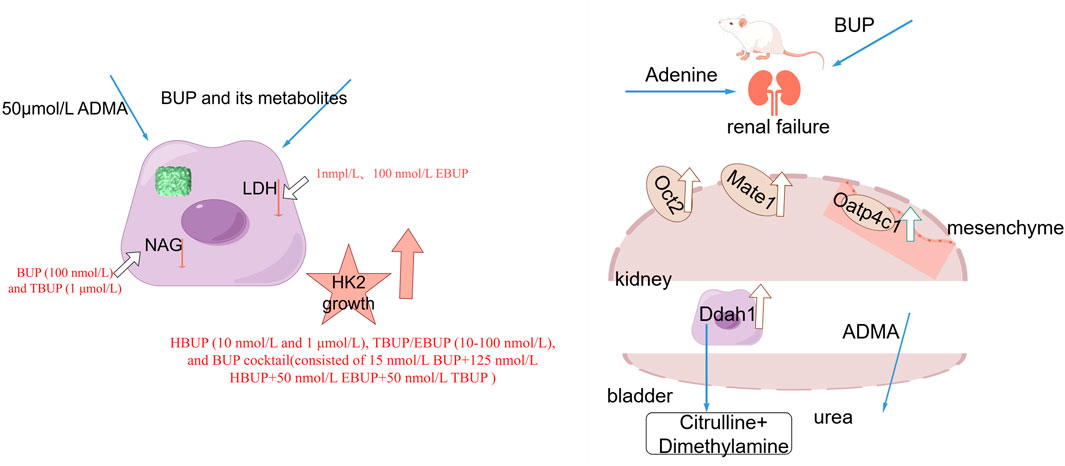
Figure 11. Proposed mechanism (By Figdraw 2.0). At 50 μmol/L ADMA, HBUP (10 nmol/L and 1 μmol/L), TBUP/EBUP (10–100 nmol/L), and BUP cocktail stimulated survival in HK2 cells. EBUP (1/100 nmol/L) lowered LDH. BUP (100 nmol/L) and TBUP (1 μmol/L) decreased NAG. Long term administration of BUP and its metabolites moderately decrease the serum level of ADMA by modulating the Oct2, Mate1, and Oatp4c1-mediated renal transport of ADMA as well as Ddah1-mediated metabolism, which alleviates the exacerbation of ADMA and retards the progression of renal interstitial lesions and fibrosis. ADMA: Asymmetrical Dimethylarginine. BUP: Bupropion. Ddah1: Dimethylarginine dimethylaminohydrolase1. LDH: Lactate dehydrogenase. Mate1: Mammalian multidrug and toxin extrusion protein 1. NAG: N-Acetyl-β-D-glucosidase. Oatp4c1: Organic anion-transporting polypeptide 4c1. Oct2: Organic cation transporter2.
Data availability statement
The original contributions presented in the study are included in the article/Supplementary Material, further inquiries can be directed to the corresponding author.
Ethics statement
Ethical approval was not required for the studies on humans in accordance with the local legislation and institutional requirements because only commercially available established cell lines were used. The animal study was approved by the Institutional Animal Care and Use Committee of Nanchang University in 2022 (Permit Number: NCULAE-20221031034). The study was conducted in accordance with the local legislation and institutional requirements.
Author contributions
LH: Data curation, Formal Analysis, Investigation, Methodology, Software, Writing – original draft, Writing – review and editing. YX: Data curation, Formal Analysis, Software, Writing – review and editing. XH: Data curation, Formal Analysis, Writing – review and editing. YY: Conceptualization, Funding acquisition, Project administration, Writing – review and editing. CZ: Data curation, Formal Analysis, Writing – review and editing. XF: Resources, Writing – review and editing. QL: Formal Analysis, Writing – review and editing. FL: Resources, Writing – review and editing. CX: Resources, Writing – review and editing. YZ: Resources, Software, Writing – review and editing. JH: Investigation, Methodology, Supervision, Writing – review and editing.
Funding
The author(s) declare that financial support was received for the research and/or publication of this article. This work was supported by the National Nature Science Foundation of China (82060677).
Conflict of interest
The authors declare that the research was conducted in the absence of any commercial or financial relationships that could be construed as a potential conflict of interest.
Generative AI statement
The author(s) declare that no Generative AI was used in the creation of this manuscript.
Publisher’s note
All claims expressed in this article are solely those of the authors and do not necessarily represent those of their affiliated organizations, or those of the publisher, the editors and the reviewers. Any product that may be evaluated in this article, or claim that may be made by its manufacturer, is not guaranteed or endorsed by the publisher.
Supplementary material
The Supplementary Material for this article can be found online at: https://www.frontiersin.org/articles/10.3389/fphar.2025.1565713/full#supplementary-material
References
Alaoui, A. C., Omari, M., Quarmich, N., Kouiri, O., Chouhani, B. A., Berraho, M., et al. (2024). Prevalence and determinant factors of depression and anxiety in people with chronic kidney disease: a Moroccan cross-sectional study. Pan Afr. Med. J. 48, 15. doi:10.11604/pamj.2024.48.15.42881
Alshelleh, S., Alhouri, A., Taifour, A., Abu-Hussein, B., Alwreikat, F., Abdelghani, M., et al. (2022). Prevelance of depression and anxiety with their effect on quality of life in chronic kidney disease patients. Sci. Rep. 12 (1), 17627. doi:10.1038/s41598-022-21873-2
Benowitz, N. L., Zhu, A. Z., Tyndale, R. F., Dempsey, D., and Jacob, P. (2013). Influence of CYP2B6 genetic variants on plasma and urine concentrations of bupropion and metabolites at steady state. Pharmacogenet Genomics 23 (3), 135–141. doi:10.1097/FPC.0b013e32835d9ab0
Böger, R. H., Bode-Böger, S. M., Tsao, P. S., Lin, P. S., Chan, J. R., and Cooke, J. P. (2000). An endogenous inhibitor of nitric oxide synthase regulates endothelial adhesiveness for monocytes. J. Am. Coll. Cardiol. 36 (7), 2287–2295. doi:10.1016/s0735-1097(00)01013-5
Bosomworth, M. P., Aparicio, S. R., and Hay, A. W. (1999). Urine N-acetyl-beta-D-glucosaminidase--a marker of tubular damage? Nephrol. Dial. Transpl. 14 (3), 620–626. doi:10.1093/ndt/14.3.620
Brunini, T. M., Da Silva, C. D., Siqueira, M. A., Moss, M. B., Santos, S. F. F., and Mendes-Ribeiro, A. C. (2006). Uremia, atherothrombosis and malnutrition: the role of L-arginine-nitric oxide pathway. Cardiovasc Hematol. Disord. Drug Targets 6 (2), 133–140. doi:10.2174/187152906777441821
Cámara-Lemarroy, C. R., Guzmán-de la Garza, F. J., Cordero-Pérez, P., Alarcón-Galván, G., Ibarra-Hernández, J. M., Muñoz-Espinosa, L. E., et al. (2013). Bupropion reduces the inflammatory response and intestinal injury due to ischemia-reperfusion. Transpl. Proc. 45 (6), 2502–2505. doi:10.1016/j.transproceed.2013.04.010
Charles, C., and Ferris, A. H. (2020). Chronic kidney disease. Prim. Care 47 (4), 585–595. doi:10.1016/j.pop.2020.08.001
Chen, J. H., and Chiang, C. K. (2021). Uremic toxins and protein-bound therapeutics in AKI and CKD: up-to-date evidence. Toxins (Basel) 14 (1), 8. doi:10.3390/toxins14010008
Chen, Y. C., Wu, M. Y., Hu, P. J., Chen, T. T., Shen, W. C., Chang, W. C., et al. (2019). Effects and safety of an oral adsorbent on chronic kidney disease progression: a systematic review and meta-analysis. J. Clin. Med. 8 (10), 1718. doi:10.3390/jcm8101718
Cinciripini, P. M., Green, C. E., Robinson, J. D., Karam-Hage, M., Engelmann, J. M., Minnix, J. A., et al. (2017). Benefits of varenicline vs. bupropion for smoking cessation: a Bayesian analysis of the interaction of reward sensitivity and treatment. Psychopharmacol. Berl. 234 (11), 1769–1779. doi:10.1007/s00213-017-4580-2
Connarn, J. N., Zhang, X., Babiskin, A., and Sun, D. (2015). Metabolism of bupropion by carbonyl reductases in liver and intestine. Drug Metab. Dispos. 43 (7), 1019–1027. doi:10.1124/dmd.115.063107
Costa, R., Oliveira, N. G., and Dinis-Oliveira, R. J. (2019). Pharmacokinetic and pharmacodynamic of bupropion: integrative overview of relevant clinical and forensic aspects. Drug Metab. Rev. 51 (3), 293–313. doi:10.1080/03602532.2019.1620763
Diwan, V., Brown, L., and Gobe, G. C. (2018). Adenine-induced chronic kidney disease in rats. Nephrol. Carlt. 23 (1), 5–11. doi:10.1111/nep.13180
Duan, D., Yang, L., Zhang, M., Song, X., and Ren, W. (2021). Depression and associated factors in Chinese patients with chronic kidney disease without dialysis: a cross-sectional study. Front. Public Health 9, 605651. doi:10.3389/fpubh.2021.605651
Gregg, L. P., and Hedayati, S. S. (2020). Pharmacologic and psychological interventions for depression treatment in patients with kidney disease. Curr. Opin. Nephrol. Hypertens. 29 (5), 457–464. doi:10.1097/MNH.0000000000000629
Greig, S. L., and Keating, G. M. (2015). Naltrexone ER/bupropion er: a review in obesity management. Drugs 75 (11), 1269–1280. doi:10.1007/s40265-015-0427-5
Gufford, B. T., Lu, J. B., Metzger, I. F., Jones, D. R., and Desta, Z. (2016). Stereoselective glucuronidation of bupropion metabolites in vitro and in vivo. Drug Metab. Dispos. 44 (4), 544–553. doi:10.1124/dmd.115.068908
Guo, J., Jiao, W., Xia, S., Xiang, X., Zhang, Y., Ge, X., et al. (2025). The global, regional, and national patterns of change in the burden of chronic kidney disease from 1990 to 2021. BMC Nephrol. 26 (1), 136. doi:10.1186/s12882-025-04028-z
Guo, X., Xing, Y., and Jin, W. (2023). Role of ADMA in the pathogenesis of microvascular complications in type 2 diabetes mellitus. Front. Endocrinol. (Lausanne) 14, 1183586. doi:10.3389/fendo.2023.1183586
Hall, B. J., Slade, S., Wells, C., Rose, J. E., and Levin, E. D. (2015). Bupropion-varenicline interactions and nicotine self-administration behavior in rats. Pharmacol. Biochem. Behav. 130, 84–89. doi:10.1016/j.pbb.2015.01.009
Hamdy, M. M., Elbadr, M. M., and Barakat, A. (2018). Bupropion attenuates morphine tolerance and dependence: possible role of glutamate, norepinephrine, inflammation, and oxidative stress. Pharmacol. Rep. 70 (5), 955–962. doi:10.1016/j.pharep.2018.04.003
Han, L. W., Gao, C., Zhang, Y., Wang, J., and Mao, Q. (2019). Transport of bupropion and its metabolites by the model CHO and HEK293 cell lines. Drug Metab. Lett. 13 (1), 25–36. doi:10.2174/1872312813666181129101507
He, J., Yu, Y., Prasad, B., Chen, X., and Unadkat, J. D. (2014). Mechanism of an unusual, but clinically significant, digoxin-bupropion drug interaction. Biopharm. Drug Dispos. 35 (5), 253–263. doi:10.1002/bdd.1890
Horowitz, J. D., and Heresztyn, T. (2007). An overview of plasma concentrations of asymmetric dimethylarginine (ADMA) in health and disease and in clinical studies: methodological considerations. J. Chromatogr. B Anal. Technol. Biomed. Life Sci. 851 (1-2), 42–50. doi:10.1016/j.jchromb.2006.09.023
Huang, L., Ning, C., He, J., Wang, M., Chen, X., Guo, X., et al. (2025). Evaluation of drug-drug interaction between rosuvastatin and tacrolimus and the risk of hepatic injury in rats. Naunyn Schmiedebergs Arch Pharmacol. doi:10.1007/s00210-024-03768-3
Íbias, J., and Nazarian, A. (2020). Sex differences in nicotine-induced impulsivity and its reversal with bupropion in rats. J. Psychopharmacol. 34 (12), 1382–1392. doi:10.1177/0269881120937543
Jefferson, J. W., Pradko, J. F., and Muir, K. T. (2005). Bupropion for major depressive disorder: pharmacokinetic and formulation considerations. Clin. Ther. 27 (11), 1685–1695. doi:10.1016/j.clinthera.2005.11.011
Karimollah, A., Hemmatpur, A., and Vahid, T. (2021). Revisiting bupropion anti-inflammatory action: involvement of the TLR2/TLR4 and JAK2/STAT3. Inflammopharmacology 29 (4), 1101–1109. doi:10.1007/s10787-021-00829-4
Khan, S. R., Berendt, R. T., Ellison, C. D., Ciavarella, A. B., Asafu-Adjaye, E., Khan, M. A., et al. (2016). Bupropion hydrochloride. Profiles Drug Subst. Excip. Relat. Methodol. 41, 1–30. doi:10.1016/bs.podrm.2015.12.001
Kielstein, J. T., Böger, R. H., Bode-Böger, S. M., Schäffer, J., Barbey, M., Koch, K. M., et al. (1999). Asymmetric dimethylarginine plasma concentrations differ in patients with end-stage renal disease: relationship to treatment method and atherosclerotic disease. J. Am. Soc. Nephrol. 10 (3), 594–600. doi:10.1681/ASN.V103594
Lim, Y. J., Sidor, N. A., Tonial, N. C., Che, A., and Urquhart, B. L. (2021). Uremic toxins in the progression of chronic kidney disease and cardiovascular disease: mechanisms and therapeutic targets. Toxins (Basel). 13 (2), 142. doi:10.3390/toxins13020142
Masereeuw, R., Mutsaers, H. A., Toyohara, T., Abe, T., Jhawar, S., Sweet, D. H., et al. (2014). The kidney and uremic toxin removal: glomerulus or tubule? Semin. Nephrol. 34 (2), 191–208. doi:10.1016/j.semnephrol.2014.02.010
Ma, Y., Zhang, M., Yang, J., Zhu, L., Dai, J., and Wu, X. (2023). Characterization of the renal tubular transport of creatinine by activity-based protein profiling and transport kinetics. Eur. J. Pharm. Sci. 180, 106342. doi:10.1016/j.ejps.2022.106342
Mikkaichi, T., Suzuki, T., Onogawa, T., Tanemoto, M., Mizutamari, H., Okada, M., et al. (2004). Isolation and characterization of a digoxin transporter and its rat homologue expressed in the kidney. Proc. Natl. Acad. Sci. U. S. A. 101 (10), 3569–3574. doi:10.1073/pnas.0304987101
Naber, T., and Purohit, S. (2021). Chronic kidney disease: role of diet for a reduction in the severity of the disease. Nutrients 13 (9), 3277. doi:10.3390/nu13093277
Nagler, E. V., Webster, A. C., Vanholder, R., and Zoccali, C. (2012). Antidepressants for depression in stage 3-5 chronic kidney disease: a systematic review of pharmacokinetics, efficacy and safety with recommendations by European Renal Best Practice (ERBP). Nephrol. Dial. Transpl. 27 (10), 3736–3745. doi:10.1093/ndt/gfs295
Nakada, T., Kudo, T., and Ito, K. (2023). Quantitative consideration of clinical increases in serum creatinine caused by renal transporter inhibition. Drug Metab. Dispos. 51 (9), 1114–1126. doi:10.1124/dmd.122.000969
Naud, J., Michaud, J., Beauchemin, S., Hébert, M. J., Roger, M., Lefrancois, S., et al. (2011). Effects of chronic renal failure on kidney drug transporters and cytochrome P450 in rats. Drug Metab. Dispos. 39 (8), 1363–1369. doi:10.1124/dmd.111.039115
Oliva-Damaso, E., Oliva-Damaso, N., Rodriguez-Esparragon, F., Payan, J., Baamonde-Laborda, E., Gonzalez-Cabrera, F., et al. (2019). Asymmetric (ADMA) and symmetric (SDMA) dimethylarginines in chronic kidney disease: a clinical approach. Int. J. Mol. Sci. 20 (15), 3668. doi:10.3390/ijms20153668
Palmer, S., Vecchio, M., Craig, J. C., Tonelli, M., Johnson, D. W., Nicolucci, A., et al. (2013). Prevalence of depression in chronic kidney disease: systematic review and meta-analysis of observational studies. Kidney Int. 84 (1), 179–191. doi:10.1038/ki.2013.77
Pu, L., Zou, Y., Wu, S. K., Wang, F., Zhang, Y., Li, G. S., et al. (2020). Prevalence and associated factors of depressive symptoms among chronic kidney disease patients in China: results from the Chinese Cohort Study of Chronic Kidney Disease (C-STRIDE). J. Psychosom. Res. 128, 109869. doi:10.1016/j.jpsychores.2019.109869
Rashidian, A., Dejban, P., Karami Fard, K., Abdollahi, A., Chamanara, M., Dehpour, A., et al. (2020a). Bupropion ameliorates acetic acid-induced colitis in rat: the involvement of the TLR4/NF-kB signaling pathway. Inflammation 43 (5), 1999–2009. doi:10.1007/s10753-020-01273-2
Rashidian, A., Dejban, P., Karami Fard, K., Abdollahi, A., Chamanara, M., Dehpour, A., et al. (2020b). Bupropion ameliorates acetic acid-induced colitis in rat: the involvement of the TLR4/NF-kB signaling pathway. Inflammation 43 (5), 19–20. doi:10.1007/s10753-020-0127-2
Sager, J. E., Price, L. S., and Isoherranen, N. (2016). Stereoselective metabolism of bupropion to OH-bupropion, threohydrobupropion, erythrohydrobupropion, and 4'-OH-bupropion in vitro. Drug Metab. Dispos. 44 (10), 1709–1719. doi:10.1124/dmd.116.072363
Schwenk, M. H., and Pai, A. B. (2016). Drug transporter function--implications in CKD. Adv. Chronic Kidney Dis. 23 (2), 76–81. doi:10.1053/j.ackd.2016.01.016
Shabaka, A., Cases-Corona, C., and Fernandez-Juarez, G. (2021). Therapeutic insights in chronic kidney disease progression. Front. Med. (Lausanne) 8, 645187. doi:10.3389/fmed.2021.645187
Shafi, T., Hostetter, T. H., Meyer, T. W., Hwang, S., Hai, X., Melamed, M. L., et al. (2017). Serum asymmetric and symmetric dimethylarginine and morbidity and mortality in hemodialysis patients. Am. J. Kidney Dis. 70 (1), 48–58. doi:10.1053/j.ajkd.2016.10.033
Sharp, J., and Brown, J. S. (2024). The intersection of chronic kidney disease and depression. Nephrol. Nurs. J. 51 (2), 165–172. doi:10.37526/1526-744x.2024.51.2.165
Shen, Y., Yu, Y., Lai, W., Li, S., Xu, Z., Jin, J., et al. (2018). Evaluation of a potential clinical significant drug-drug interaction between digoxin and bupropion in cynomolgus monkeys. Pharm. Res. 36 (1), 1. doi:10.1007/s11095-018-2525-z
Stopfer, P., Giessmann, T., Hohl, K., Hutzel, S., Schmidt, S., Gansser, D., et al. (2018). Optimization of a drug transporter probe cocktail: potential screening tool for transporter-mediated drug-drug interactions. Br. J. Clin. Pharmacol. 84 (9), 1941–1949. doi:10.1111/bcp.13609
Stopfer, P., Giessmann, T., Hohl, K., Sharma, A., Ishiguro, N., Taub, M. E., et al. (2016). Pharmacokinetic evaluation of a drug transporter cocktail consisting of digoxin, furosemide, metformin, and Rosuvastatin. Clin. Pharmacol. Ther. 100 (3), 259–267. doi:10.1002/cpt.406
Strobel, J., MüLLER, F., Zolk, O., Endreß, B., König, J., Fromm, M. F., et al. (2013). Transport of asymmetric dimethylarginine (ADMA) by cationic amino acid transporter 2 (CAT2), organic cation transporter 2 (OCT2) and multidrug and toxin extrusion protein 1 (MATE1). Amino Acids 45 (4), 989–1002. doi:10.1007/s00726-013-1556-3
Sundström, J., Bodegard, J., Bollmann, A., Vervloet, M. G., Mark, P. B., Karasik, A., et al. (2022). Prevalence, outcomes, and cost of chronic kidney disease in a contemporary population of 2·4 million patients from 11 countries: the CaReMe CKD study. Lancet Reg. Health Eur. 20 (20), 100438. doi:10.1016/j.lanepe.2022.100438
Taghikhani, E., Maas, R., Fromm, M. F., and König, J. (2019). The renal transport protein OATP4C1 mediates uptake of the uremic toxin asymmetric dimethylarginine (ADMA) and efflux of cardioprotective L-homoarginine. PLoS One 14 (3), e0213747. doi:10.1371/journal.pone.0213747
Taheri, P., Keshavarzi, S., Ebadi, M., Motaghinejad, M., and Motevalian, M. (2018). Neuroprotective effects of forced exercise and bupropion on chronic methamphetamine-induced cognitive impairment via modulation of cAMP response element-binding protein/brain-derived neurotrophic factor signaling pathway, oxidative stress, and inflammatory biomarkers in rats. Adv. Biomed. Res. 7 (7), 151. doi:10.4103/abr.abr_11_18
Tain, Y. L., and Hsu, C. N. (2017). Toxic dimethylarginines:asymmetric dimethylargi-nine (ADMA) and symmetric dimethylarginine (SDMA). Toxins (Basel) 9 (3), 92. doi:10.3390/toxins9030092
Taub, M. E., Mease, K., Sane, R. S., Watson, C. A., Chen, L., Ellens, H., et al. (2011). Digoxin is not a substrate for organic anion-transporting polypeptide transporters OATP1A2, OATP1B1, OATP1B3, and OATP2B1 but is a substrate for a sodium-dependent transporter expressed in HEK293 cells. Drug Metab. Dispos. 39 (11), 2093–2102. doi:10.1124/dmd.111.040816
Toyohara, T., Suzuki, T., Morimoto, R., Akiyama, Y., Souma, T., Shiwaku, H. O., et al. (2009). SLCO4C1 transporter eliminates uremic toxins and attenuates hypertension and renal inflammation. J. Am. Soc. Nephrol. 20 (12), 2546–2555. doi:10.1681/ASN.2009070696
Tsikas, D. (2020). Urinary dimethylamine (DMA) and its precursor asymmetric dimethylarginine (ADMA) in clinical medicine, in the context of nitric oxide (NO) and beyond. J. Clin. Med. 9 (6), 1843. doi:10.3390/jcm9061843
U.S. Department of Health and Human Services Food and Drug Administration Center for Drug Evaluation and Research (CDER). (2020). Clinical drug interaction studies — cytochrome P450 enzyme- and transporter-mediated drug interactions guidance for industry
Wang, L., Xu, X., Zhang, M., Hu, C., Li, C., et al. (2023). Prevalence of chronic kidney disease in China: results from the sixth China chronic disease and risk factor surveillance. JAMA Intern Med. 183 (4), 298–310. doi:10.1001/jamainternmed.2022.6817
Worrall, S. P., Almond, M. K., and Dhillon, S. (2004). Pharmacokinetics of bupropion and its metabolites in haemodialysis patients who smoke. A single dose study. Nephron Clin. Pract. 97 (3), c83–c89. doi:10.1159/000078635
Xu, S., Bian, R., and Chen, X. (1982). Experimental methodology of pharmacology. 3rd edition. Beijing: People's Medical Publishing House.
Yamaguchi, H., Sugie, M., Okada, M., Mikkaichi, T., Toyohara, T., Abe, T., et al. (2010). Transport of estrone 3-sulfate mediated by organic anion transporter OATP4C1: estrone 3-sulfate binds to the different recognition site for digoxin in OATP4C1. Drug Metab. Pharmacokinet. 25 (3), 314–317. doi:10.2133/dmpk.25.314
Yang, Q., Su, S., Luo, N., and Cao, G. (2024). Adenine-induced animal model of chronic kidney disease: current applications and future perspectives. Ren. Fail 46 (1), 2336128. doi:10.1080/0886022X.2024.2336128
Yetkin, D., Yılmaz, İ. A., and Ayaz, F. (2023). Anti-inflammatory activity of bupropion through immunomodulation of the macrophages. Naunyn Schmiedeb. Arch. Pharmacol. 396 (9), 2087–2093. doi:10.1007/s00210-023-02462-0
Glossary
ADMA Asymmetrical Dimethylarginine
ALB Albumin
AO Acridine Orange
AUC the area under the plasma concentration time curve
Bcrp Breast cancer resistance protein
Bun Urea nitrogen
BUP Bupropion
CCK-8 Cell Counting Kit-8
CKD Chronic kidney disease
Cmax peak plasma concentration
Cre Creatinine
CYP Cytochrome P450
Cys-c Cystatin-C
Ddah1 Dimethylarginine dimethylaminohydrolase1
DIA Diazepam
DIG Digoxin
DMEM Dulbecco’s Modified Eagle Medium
EB Ethidium Bromide
EBUP Erythro-hydrobupropion
ECL Enhanced Chemiluminescence
ESI Electro-Spray Ionization
FUR Furosemide
HBUP Hydroxybupropion
HK2 Human kidney 2
HRP Horseradish Peroxidase
KIM-1 Kidney injury molecule-1
LC Liquid chromatography
LDH Lactate dehydrogenase
Mate1 Mammalian multidrug and toxin extrusion protein 1
MET Metformin
MRM Multiple Reaction Monitoring
Mrp2 Multidrug resistance-associated protein 2
MS/MS Tandem mass spectrometry
NAG N-Acetyl-β-D-glucosidase
CLrenal Renal Clearence
Oatp Organic anion-transporting polypeptide
Oct2 Organic cation transporter2
P-gp P-glycoprotein
PMSF Phenylmethanesulfonyl fluoride
PVDF Polyvinylidene fluoride
RSD RSV Relative Standard Deviation Rosuvastatin
SD Standard Deviation
TBUP Threo-hydrobupropion
T1/2 Terminal half-life
UGT Uridine Diphosphate Glycosyltransferase
β2-MG β2-microglobulin
Keywords: bupropion and its metabolites, asymmetrical dimethylarginine, chronic renal injury, renal transporters, metabolism enzyme
Citation: Huang L, Xiao Y, Han X, Yu Y, Zheng C, Fang X, Li Q, Liu F, Xia C, Zhang Y and He J (2025) Bupropion decreases plasma levels of asymmetric dimethylarginine and ameliorates renal injury by modulation of Ddah1, Oatp4c1, Oct2, and Mate1 in rats with adenine-induced chronic renal injury. Front. Pharmacol. 16:1565713. doi: 10.3389/fphar.2025.1565713
Received: 23 January 2025; Accepted: 02 May 2025;
Published: 22 May 2025.
Edited by:
Krishna M. Boini, University of Houston, United StatesReviewed by:
Samar F. Darwish, Badr University in Cairo, EgyptNaresh Kshirasagar, Texas A&M University, United States
Copyright © 2025 Huang, Xiao, Han, Yu, Zheng, Fang, Li, Liu, Xia, Zhang and He. This is an open-access article distributed under the terms of the Creative Commons Attribution License (CC BY). The use, distribution or reproduction in other forums is permitted, provided the original author(s) and the copyright owner(s) are credited and that the original publication in this journal is cited, in accordance with accepted academic practice. No use, distribution or reproduction is permitted which does not comply with these terms.
*Correspondence: Jiake He, aGprOTg3QHNpbmEuY29t
†These authors have contributed equally to this work
 Lulu Huang1,2,3†
Lulu Huang1,2,3† Yun Xiao
Yun Xiao Xiangdong Fang
Xiangdong Fang Fanglan Liu
Fanglan Liu Chunhua Xia
Chunhua Xia Yongjie Zhang
Yongjie Zhang Jiake He
Jiake He
